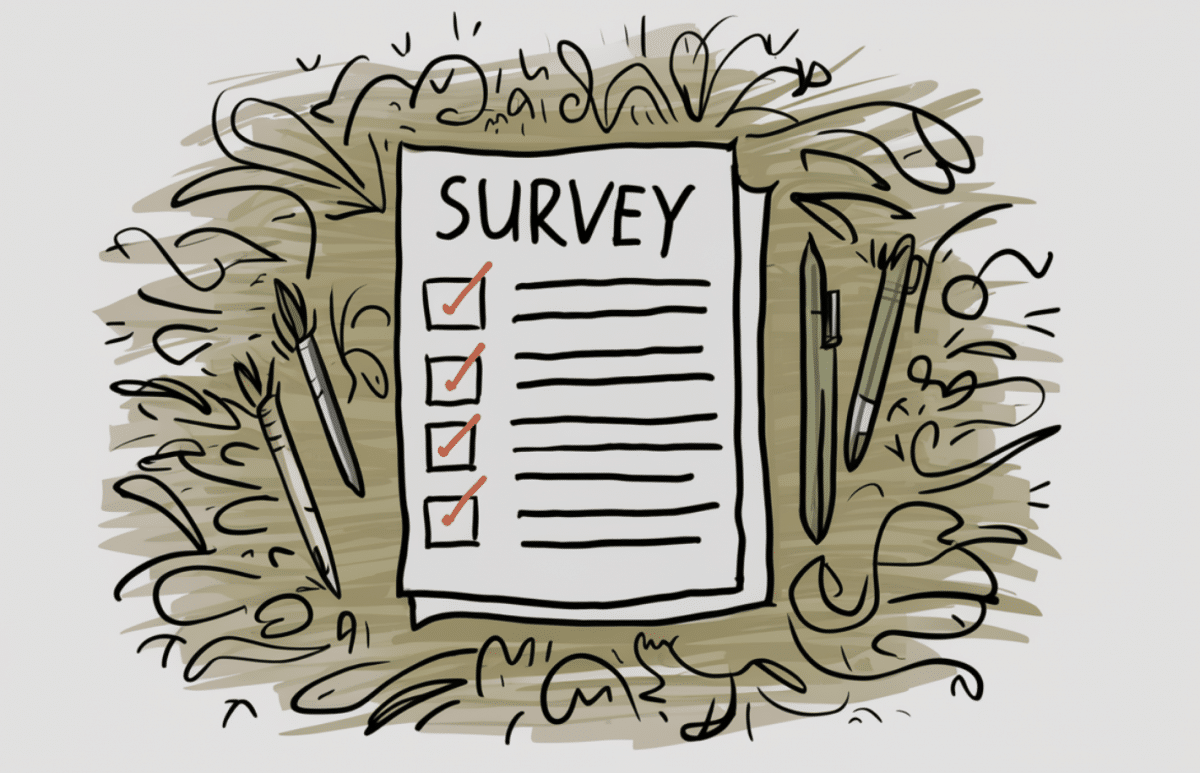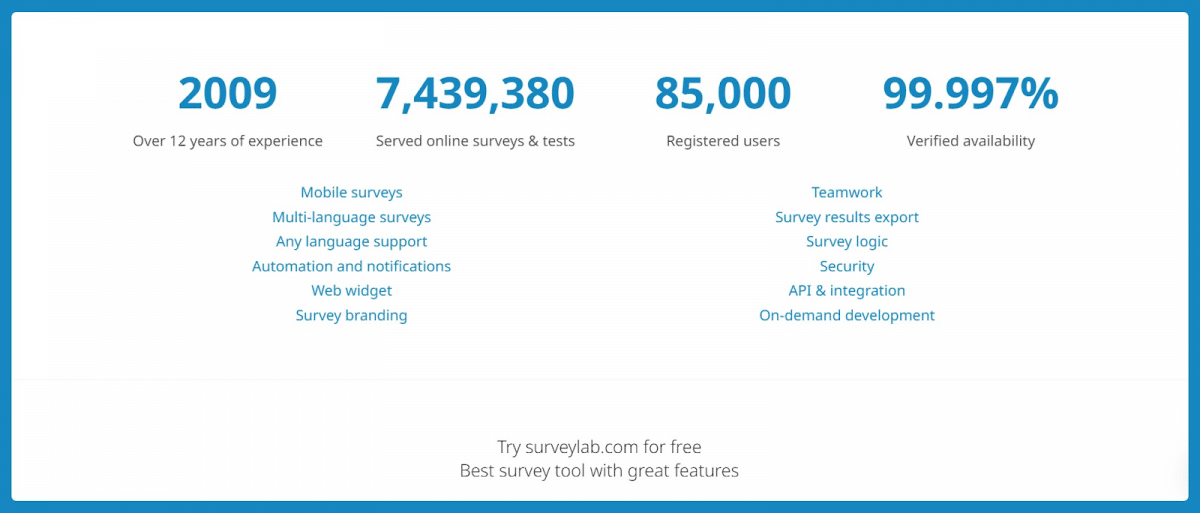With surveys, the thing is: it’s all about asking the right questions. In our guide, we’re diving into the art of formulating perfect, close ended questions.
Multiple choice magic, the clarity of single word answers, and the power of quantitative data – it’s all here.
Ready to give your survey a serious accuracy boost? Let’s get into it!
What are close ended questions?
Close ended questions in surveys provide a limited number of choices, like multiple choice or rating scales.
Unlike open ended ones, they limit responses to predetermined choices, which makes data collection and statistical analysis much easier. Ideal for quantifiable data, they’re user-friendly and save time. You’ve got direct insight without needing respondents to elaborate or asking many additional questions.
When to use close ended questions?
If you have some doubts, we’ve come up with a few examples.
#1 Quantitative data collection
Close ended questions are great when you need to collect quantifiable data for statistical analysis. Multiple choice or rating scale questions in surveys allow for easy aggregation of responses.
🟩 Great for: companies looking to analyze customer feedback or opinions in a structured, numerical way. It gives you more precise data, which helps a lot in making smart business choices.
#2 Time-efficient surveys
When survey time is limited, close ended questions are the way to go. They require less time to complete compared to open ended questions, as respondents choose from a predetermined list of answers.
🟩 Great for: quick feedback collection, for instance, in customer satisfaction surveys where every second counts.
#3 Large-scale response analysis
For surveys with many respondents, closed ended questions simplify the analysis process. Use limited response options like ‘agree or disagree’ or a Likert scale to make it simpler to compare and see the differences in answers across a broad audience.
🟩 Great for: market research where understanding general trends is more relevant than gathering detailed individual insights.
#4 Clarity and consistency in responses
Closed ended questions provide clarity and consistency in survey responses. By limiting answers to a specific set of choices, they reduce the ambiguity that can arise from open ended responses.
🟩 Great for: times when you need simple answers, like figuring out what products people prefer or how satisfied customers are.
8 Examples of close ended questions
Now that you know when to use close ended questions, let’s see what their types are and how you can use them not only in a close ended survey, but also to collect data from survey respondents… anywhere you want.
01 Multiple choice questions
Multiple choice questions are standard in close ended surveys. They give respondents a bunch of predetermined answers, which makes it more convenient to collect and analyze data.
Closed-ended questions are your go-to when you need to lead to statistical analysis, especially to see common opinions or choices. They’re helpful for crunching numbers, but they might not get as deep into details as open-ended questions do.
Example: What is your favorite type of cuisine? a) Italian b) Chinese c) Mexican d) Indian

02 Likert scale questions
Likert scale questions are used to measure attitudes or opinions. They typically range from ‘strongly agree’ to ‘strongly disagree’ and provide a nuanced view of respondents’ feelings. You can use it in customer feedback surveys, as they quantify subjective responses, making them easier to analyze.
Example: How satisfied are you with our customer service? 1 – Not at all satisfied, 2 – Slightly satisfied, 3 – Neutral, 4 – Satisfied, 5 – Very satisfied
03 Dichotomous Questions
They’re usually framed as ‘Yes/No’ or ‘True/False’ and provide you with straightforward, decisive answers. Dichotomous questions are suitable for collecting clear-cut data or when detailed answers are not practical or necessary.
However, they might not capture the nuances of respondents’ opinions as effectively as multiple choice questions.
Example: Do you currently use our product? Yes/No
04 Rating scale questions
They let respondents rate something on a scale, for instance from 1 to 5 or 1 to 10. Using them can be a great way to find out how satisfied people are with a product or service or to compare different parts of it. You get numbers that are easy to work with, but they might not tell you why someone gave a certain rating.
Example: On a scale of 1 to 10, how would you rate the quality of our product?
05 Demographic questions
Gathering specific details like age, gender, or job? These are called demographic questions and are later used to divide up survey responses and get to know what different groups of people prefer or how they behave.
Conduct them in a way that respects people’s privacy and makes sure they’re relevant to what the survey is trying to find out.
Example: What is your age group? a) Under 20 b) 21-30 c) 31-40 d) 41-50 e) Over 50
When designing demographic questions, especially those related to age, precision is must-have for categorizing your respondents correctly. A solid age calculator can help ensure that respondents are grouped accurately.
06 Single answer questions
If you want respondents to choose one thing, like their favorite part of a product, opt for choosing single answer questions. Analyzing answers takes less time, but it might not show all the details of respondents’ likes and dislikes as well as multiple choice questions can.
Example: Which feature of our app do you find most useful? a) Navigation b) Notifications c) Customization options d) Social sharing
07 Closed ended personal questions
Closed ended personal questions ask about personal preferences or experiences but limit responses to predefined options. They’re less intrusive than open ended personal questions and are easier for respondents to answer.
Example: How often do you exercise per week? a) Not at all b) 1-2 times c) 3-4 times d) More than 4 times
08 Binary outcome questions
Similarly to dichotomous ones, they provide two opposite choices, like ‘satisfied/unsatisfied.’
Perfect for quick insights into specific issues. But here’s the thing – they lack the depth and range of responses that other closed ended question types, like multiple choice or rating scales, might provide.
Example: Was our website easy to navigate? Yes/No

Good Practices for Close Ended Questions
How to ask your survey questions to get a set of responses answered that is satisfying for you? Read our best practices.
1. Take advantage of software for creating surveys
Try using Surveylab. It’s got handy tools to assist you in creating questions easily, ready-made answer options, and simple templates. The tool also sorts and analyzes answers for you, so you can understand your results faster.
Without any hassle, your survey will be exactly what you’ve been looking for.

2. Collect quantitative data with precision
Design closed-ended questions carefully to effectively collect quantitative data. You should use a few clear and specific answer choices, so respondents can easily pick the one that fits best for them. Such a method is key for statistical analysis because it gives clean, number-based data that’s simple to understand and compare.
3. Create effective multiple choice questions
A well-formulated, easy-to-follow multiple choice question may decide if the respondents are going to continue taking surveys or not. That’s why you should take special care in designing those. Double-check if the multiple options cover all potential answers so respondents aren’t pushed into choosing alternatives that don’t truly reflect their views.
4. Use rating scales for detailed feedback
Rating scale questions allow respondents to express their opinions on a scale and give more context than a single word answer. That’s why they’re invaluable for collecting accurate feedback in a quantifiable format. It’s quite often used to measure customer satisfaction or attitudes towards a product or service.
5. Limit responses for clearer data
Want to obtain clearer and more consistent data? Maybe limiting responses to close ended questions can help.
Respondents may find the survey less difficult to take, and the data is quicker to interpret for companies. Once you just need simple, direct answers, limited responses really come in handy.
6. Balance qualitative insights with quantitative data
While close ended questions are intended to collect quantitative data, they can also provide qualitative insights. Carefully designing questions and answer choices, you can glean a richer understanding from the responses. Consider this balance, especially in case you’re trying to figure out why people behave the way they do.
📰 See 10 tricks to help you build better surveys.

When is a close-ended question not the right idea?
Looking for in-depth, qualitative data? Maybe you should look for something else than close ended questions.
If the goal is to understand complex opinions, feelings, or experiences, let respondents answer freely in their own words. Open ended questions are more suitable in these scenarios since they allow a richer qualitative analysis.
Questions, where respondents answer using their own words might be an option for a company to uncover the subtle details in customer responses. Closed-ended questions have their perks, like making analysis simpler and responses clearer. But, they might not catch all the insights that you can get from open-ended questions. It’s true when you apply statistical analysis techniques.
Conclusion
The choice between open ended and closed ended questions in surveys makes a huge difference.
Knowing when to use different types of questions is a must for any company that wants to collect relevant information. The decision on which type to use depends on what the survey aims to achieve and the kind of information that’s needed to help make good decisions.
Closed ended questions, with their structured answer options, lead to straightforward analysis and clear data, which is beneficial for companies looking to quantify customer feedback. They shine in scenarios where responses can be easily categorized, like in multiple choice questions or rating scale questions.
However, when the goal is to get more information into the thoughts and feelings of customers, open ended questions take the lead. Respondents can answer what they want, providing richer, more nuanced insights.
Sign up for Surveylab, and create powerful surveys with both closed and open ended questions with ease.
FAQ on close-ended questions
Any doubts on the topic? Let’s go through the frequently asked questions.
Close ended questions are the type where you give specific answers to choose from. These answers can be yes or no, multiple choice, or a rating scale. They make it easy to collect and analyze data because all responses are standard.
It is not good to use close ended questions when you want detailed feedback or opinions. They limit how much respondents can share. If you want to understand feelings or complex views, open ended questions are better.
Keep them simple and clear. Ensure that the choices cover all possible answers so respondents don’t feel stuck. Also, using tools like SurveyLab can help you design, administer, and analyze surveys more efficiently.

Leave a Message
You must be logged in to post a comment.